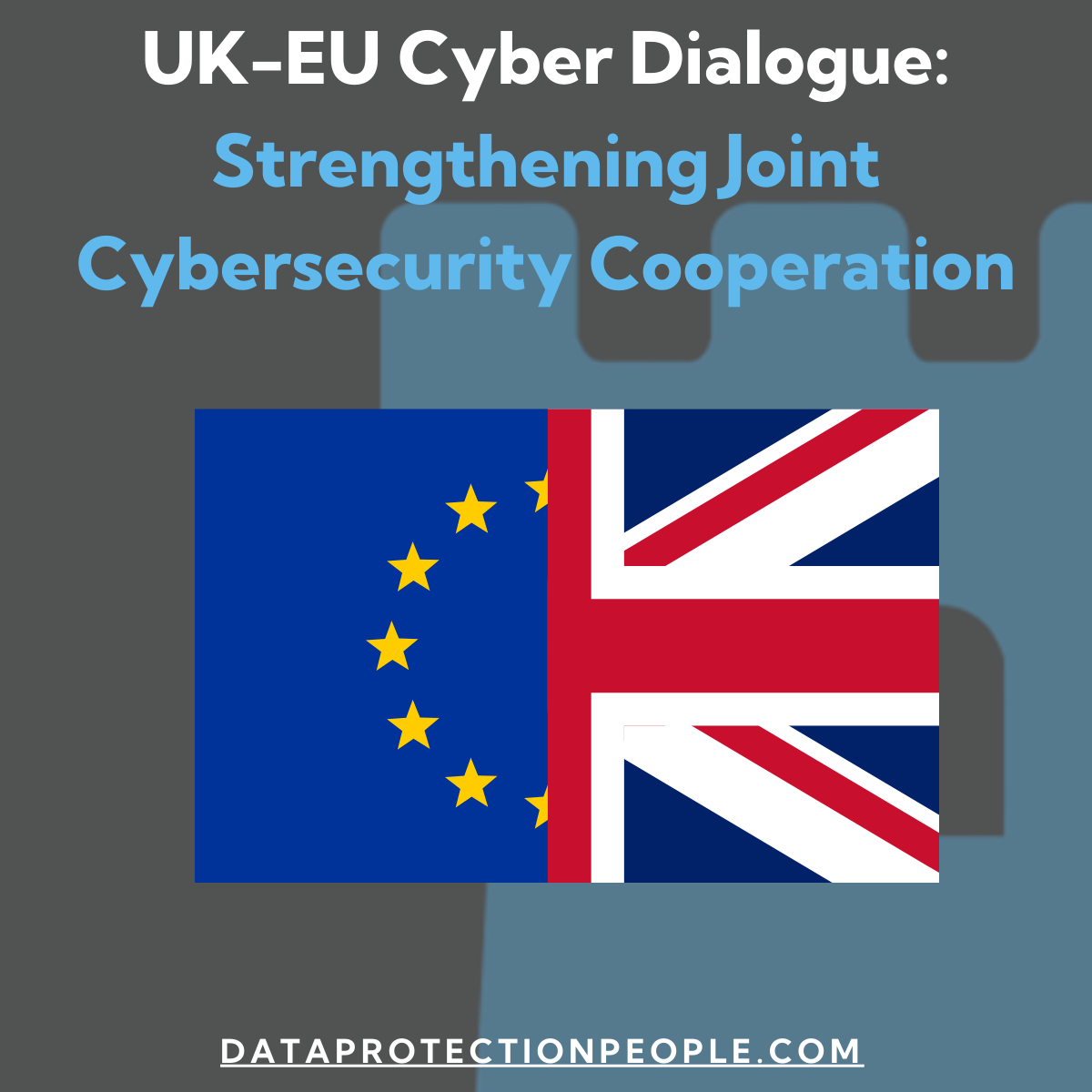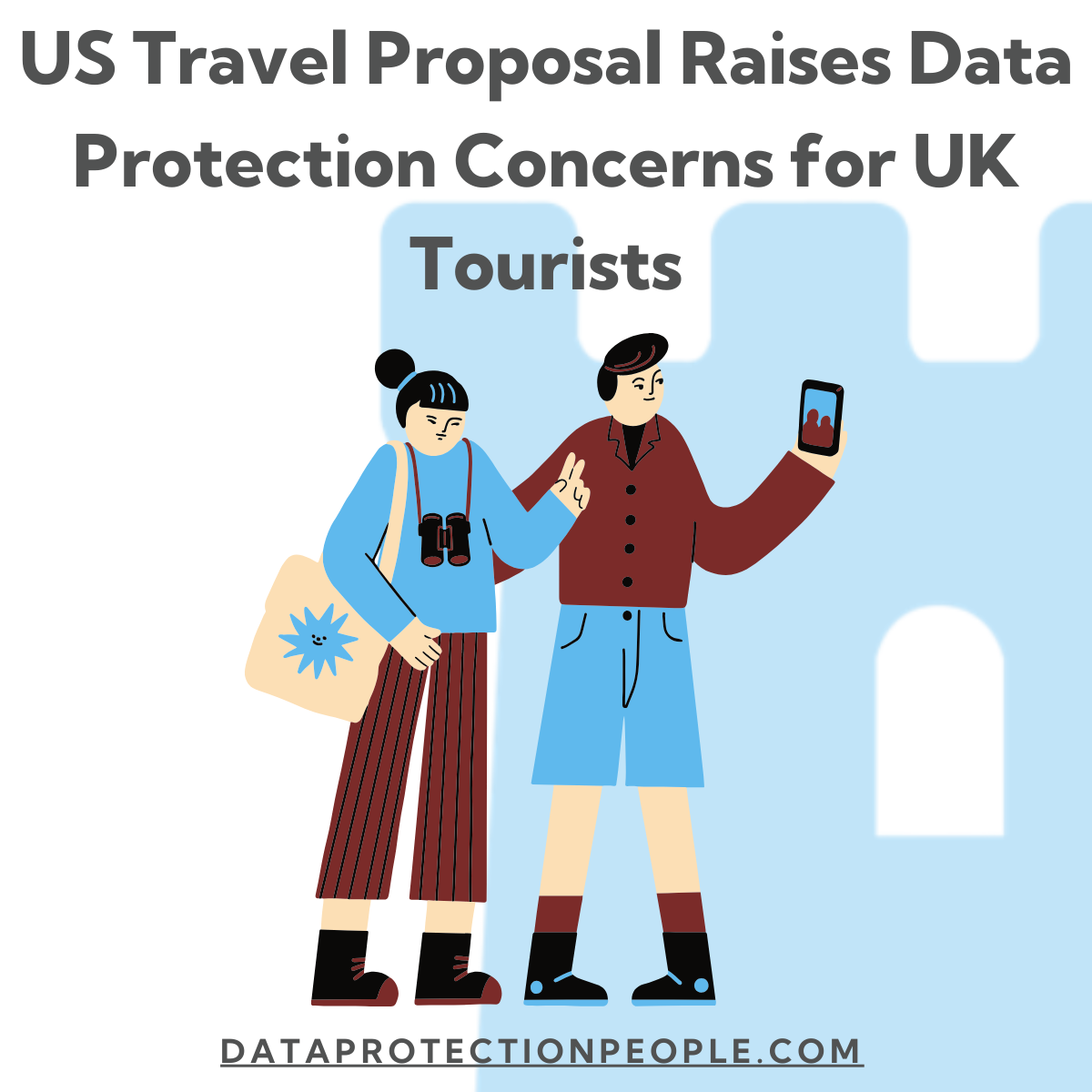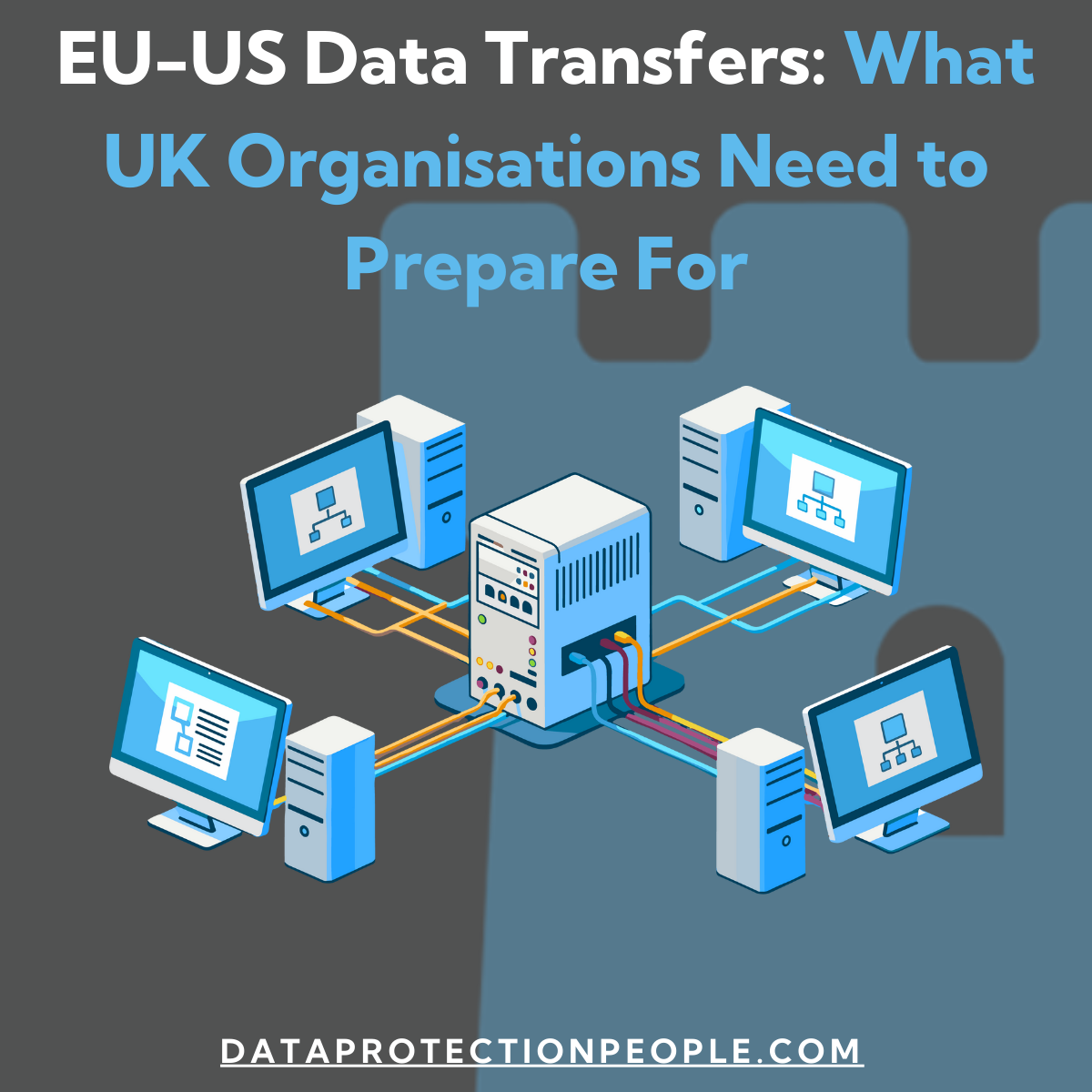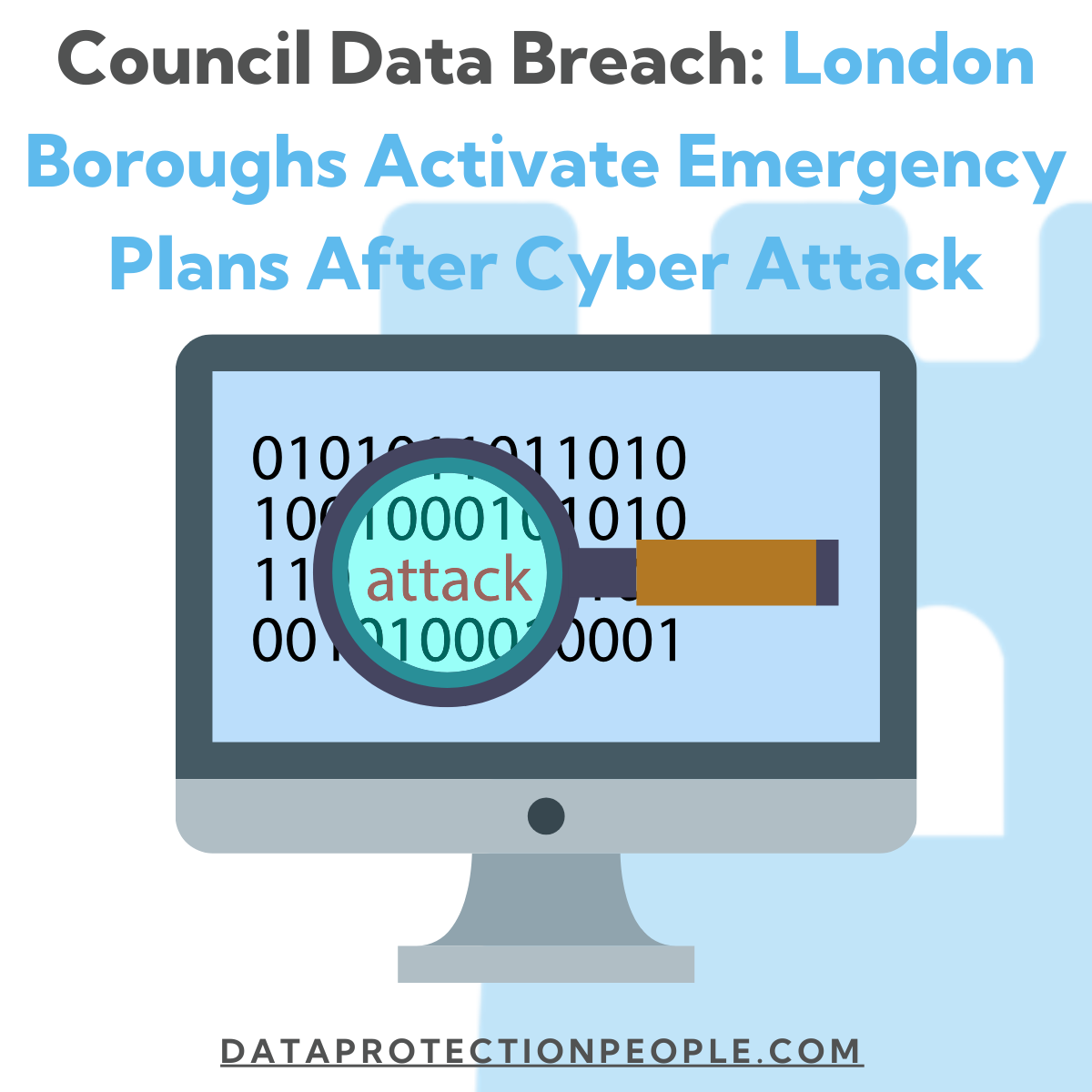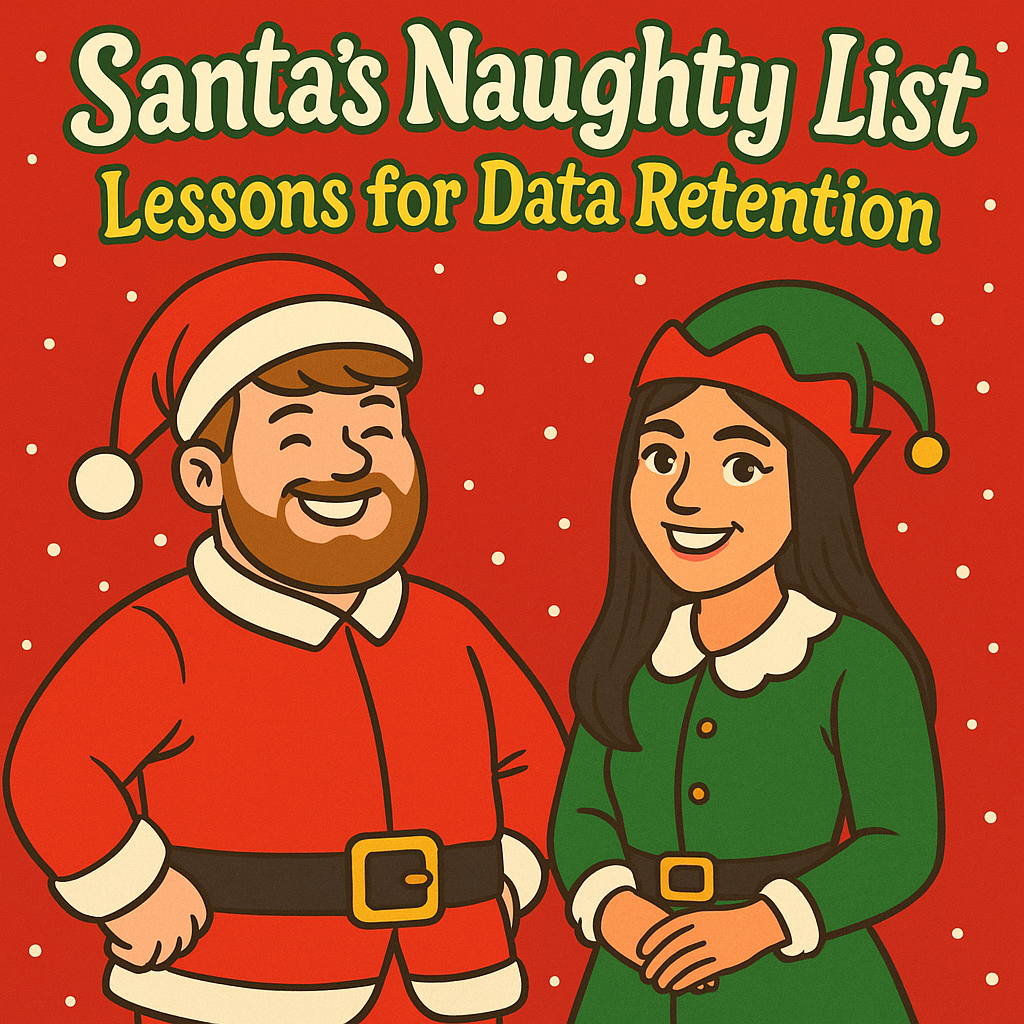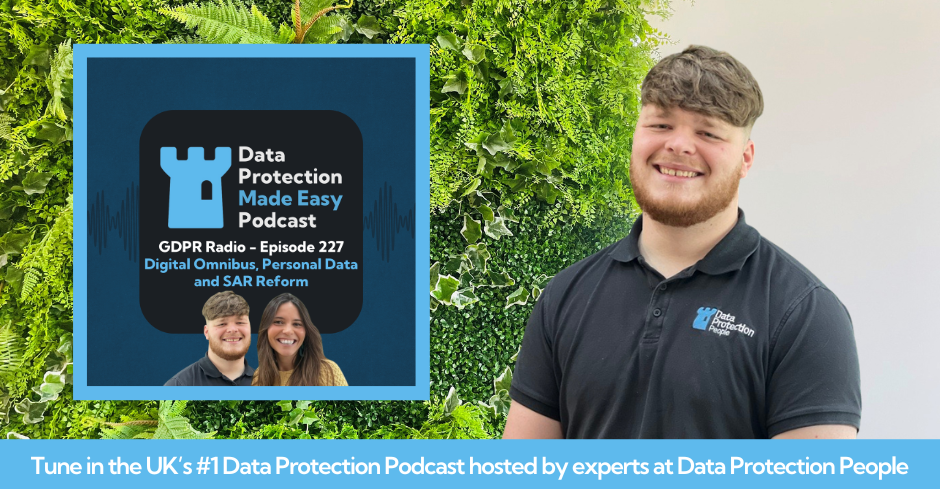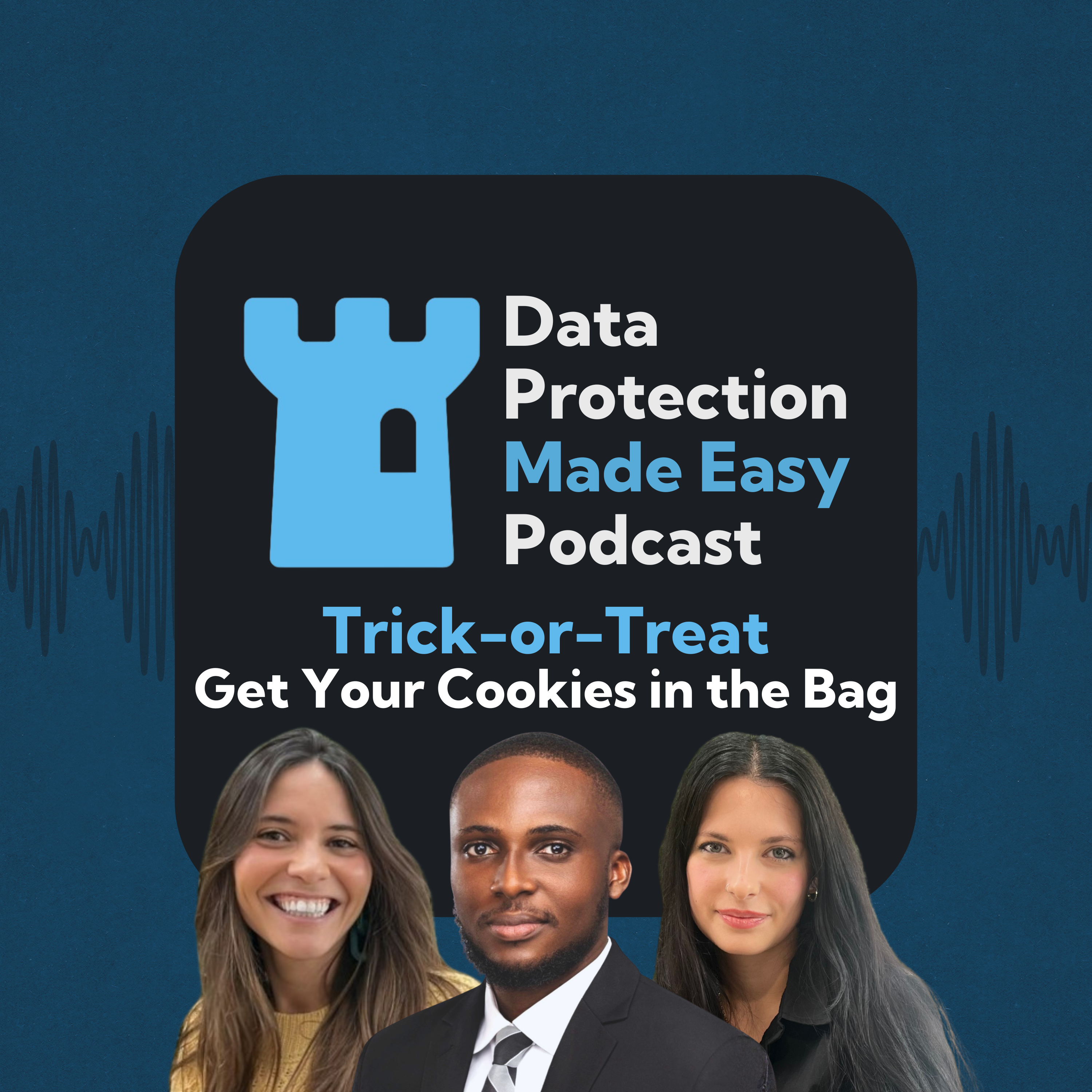Resources
Podcasts, Guides, Updates & More

Join our extensive list of clients who have their data privacy under control
Data Protection People Blogs
Data Privacy Learning & Guidance
Our mission is to make data protection easy: easy to understand and easy to do. Our weekly podcasts are available in our Resource Centre along with a collection of articles, white papers, useful guidance, templates, case law, and opinions – providing you with tools you can utilise in your workplace.
UK-EU Cyber Dialogue: Strengthening Joint Cybersecurity Cooperation
UK-EU Cyber Dialogue: Strengthening Joint Cybersecurity Cooperation
The third UK-EU Cyber Dialogue took place in Brussels on 9 and 10 December 2025, bringing senior officials from the United Kingdom and the European Union together to advance cooperation on cyber security policy, regulatory alignment and operational resilience. Held under the framework of the UK-EU Trade and Cooperation Agreement, this annual dialogue reinforces shared priorities in an increasingly complex cyber threat landscape.
What’s New / What Happened
The third UK-EU Cyber Dialogue was co-chaired by officials from both sides, including Andrew Whittaker from the UK Foreign, Commonwealth & Development Office and Irfan Hemani from the UK Department for Science, Innovation and Technology. On the EU side, Maciej Stadajek from the European External Action Service and Christiane Kirketerp de Viron from the European Commission led discussions. Representatives from the UK National Cyber Security Centre, the Home Office and key EU agencies such as Europol and ENISA also participated.
Both parties agreed to hold the next Cyber Dialogue in London in 2026, continuing the annual tradition of structured engagement on mutual cyber security priorities.
Why This Matters for UK Organisations
The UK-EU Cyber Dialogue plays a strategic role in aligning cyber policy and resilience efforts between two major global economies. Given the interconnected nature of cyber threats, including ransomware, state-sponsored attacks and supply-chain vulnerabilities, coherent and coordinated approaches help to minimise disruption and support cross-border trade and investment.
Key areas of focus at the third Cyber Dialogue included:
- Exchanging views on current and emerging cyber threat landscapes, including deterrence strategies and incident response cooperation.
- Discussing approaches to align cyber security legislation while seeking to reduce unnecessary compliance burdens on industry.
- Countering cybercrime including ransomware and other malicious activities that impact businesses and individuals alike.
- Enhancing cyber capacity building and mechanisms for crisis coordination across jurisdictions.
- Promoting responsible state behaviour in cyberspace, referencing discussions at multilateral forums such as the United Nations.
For UK organisations, these dialogues are not just diplomatic events: they shape the future of cyber policy frameworks that affect regulatory expectations, cross-border incident response cooperation and compliance strategies for private and public sector entities alike.
What You Should Be Doing Now
UK organisations should view the Cyber Dialogue outcomes as part of a broader trend toward deeper cyber cooperation with the EU. Practical steps to prepare and align your organisation include:
- Review your cyber risk management framework – Ensure it reflects current threat intelligence and aligns with emerging UK and EU policy trends.
- Update incident response plans – Confirm processes are compatible with cross-border cooperation and reporting expectations under UK and EU regimes.
- Check regulatory compliance -Monitor EU cyber regulation developments (such as the Cyber Resilience Act and NIS2 Directive) and assess their relevance to UK operations, especially for organisations operating in or trading with the EU.
- Train security and compliance teams -Ensure staff understand how cooperative frameworks may affect risk profiling, regulatory expectations and incident escalation workflows.
- Engage with sector bodies -Participate in industry cyber forums or public consultations to shape policy and better understand implementation expectations.
Our View / Final Thoughts
The third UK-EU Cyber Dialogue underscores the importance of structured cooperation in a domain where threats are transnational, rapid and constantly evolving. Both sides have reaffirmed a shared commitment to proactive cyber security, legislative alignment and resilience building. For UK organisations, staying informed about these engagements helps to ensure that internal cyber policies, incident response strategies and compliance frameworks are fit for a world where digital threats do not respect borders.
Looking ahead, the planned 2026 dialogue in London offers an opportunity for UK stakeholders to deepen engagement, share lessons from implementation of cyber resilience initiatives and focus on practical, interoperable measures that support resilient digital infrastructure for businesses and citizens alike.
FAQs
What is the UK-EU Cyber Dialogue?
The UK-EU Cyber Dialogue is an annual meeting under the UK-EU Trade and Cooperation Agreement where senior officials exchange views on cyber policy, capacity building, deterrence strategies and regulatory approaches to strengthen mutual cyber security cooperation.
Who participates in the Cyber Dialogue?
The dialogue brings together representatives from government departments and agencies responsible for cyber security, digital policy and law enforcement from both the UK and the EU.
Does this affect UK law?
While the Cyber Dialogue itself does not change UK law, it influences policy alignment, best practice adoption and cooperative incident response expectations between the UK and EU. Organisations operating cross-border should consider how evolving standards may shape compliance landscapes.
Will future dialogues have practical outcomes?
Yes. Future dialogues are expected to build on shared priorities, focusing on areas such as cyber crime deterrence, capacity building, regulatory convergence and coordinated crisis response mechanisms.
References and Useful Sources
- UK Government: The third UK-EU Cyber Dialogue took place in Brussels
- EEAS: EU-UK Third Cyber Dialogue
- DataGuidance: EU and UK hold third Cyber Dialogue
- EU Commission: Cybersecurity Policies and Cooperation
US Travel Proposal Raises Data Protection Concerns for UK Tourists
US Travel Proposal Raises Data Protection Concerns for UK Tourists
UK tourists planning a trip to the United States may soon face new and far-reaching data collection requirements. A proposal published by US authorities suggests that visitors from visa waiver countries, including the UK, could be required to provide up to five years of social media history as part of the ESTA application process.
While the proposal is framed as a security measure, it raises important questions about privacy, digital rights, and proportionality. For UK individuals and organisations, it also highlights the growing tension between border security and personal data protection.
Why This Matters Now
The proposal comes as the US prepares for a major increase in international visitors. The country will host the men’s football World Cup in 2026 and the Olympic Games in Los Angeles in 2028.
Since returning to office in January, President Trump has placed renewed focus on border control and national security. Expanded data collection has become a key part of that approach.
For UK travellers, this could mark a significant change. Social media profiles often reveal political opinions, beliefs, associations, and details of private life. Requiring years of online activity for short-term travel raises questions about fairness and necessity.
Under UK GDPR principles, collecting this volume of personal data would require strong justification. Transparency and proportionality would be essential.
What the Proposal Includes
The proposal was submitted by the US Department of Homeland Security and Customs and Border Protection. It was published in the Federal Register and is now open for public consultation.
If implemented, ESTA applicants could be asked to provide:
• Social media information covering the last five years
• Telephone numbers used during the last five years
• Email addresses used over the last ten years
• Additional information about family members
The proposal does not explain how social media content would be assessed. It also does not clarify which platforms would be included or how long the data would be stored.
US authorities have stated that this is not a final rule. Public feedback will be accepted for 60 days.
Privacy and Digital Rights Risks
Digital rights organisations have warned that mandatory social media disclosure could cause significant civil liberties concerns. Social media content is rarely clear or objective. Posts are often informal, emotional, or taken out of context.
There is also a risk of profiling. Applicants could face delays or refusals based on lawful expression or misunderstood online activity.
From a data protection perspective, the key concerns include:
• Limited transparency around decision-making
• Unclear data retention and sharing practices
• The impact on third parties named or shown in posts
• Pressure on individuals to self-censor online
These risks reflect earlier criticism of social media vetting for student and work visas.
International Data Transfers and UK GDPR
UK GDPR does not apply directly to US border authorities. However, the proposal still has implications for UK organisations.
Employees travelling to the US may share information connected to their professional lives. Personal social media accounts often overlap with work networks and communications.
This reinforces the importance of data minimisation. UK GDPR requires organisations to collect only what is necessary. Reviewing five years of social media for short-term tourism would likely face strong scrutiny in the UK.
What UK Travellers Should Consider
The proposal is still under consultation. However, travellers should stay informed and cautious.
• Review privacy settings on social media platforms
• Avoid sharing unnecessary personal information publicly
• Follow official guidance before submitting extra data
• Be alert to scams using the proposal as a pretext
Any request for information should come only through official US government channels.
What This Means for Organisations
UK organisations with staff travelling to the US should take note. Increased scrutiny of online activity can expose business-related information.
Organisations should consider:
• Reviewing travel and data protection policies
• Providing staff guidance on digital footprints
• Assessing how business information appears online
• Supporting staff who raise privacy concerns
Our Data Protection Training and Data Protection Support services help organisations manage these evolving risks.
Our View
At Data Protection People, we see this proposal as part of a broader shift towards digital surveillance at borders. While security is important, broad data collection must remain fair, necessary, and proportionate.
Our Data Protection Consultant Manager, Catarina Santos, shares her view:
“As a data protection consultant, this proposal makes me uneasy – not for political reasons, but legal and rights-based ones.
Asking ordinary tourists for five years of social media activity feels like a significant shift from identity checks to judgement of expression and behaviour. Social media content is messy, contextual, and often misunderstood. Treating it as a reliable risk signal is questionable at best.
The concern isn’t whether states can protect their borders – they can and should – but whether collecting such broad personal data is necessary, fair, and proportionate for short-term visitors who have no real ability to challenge decisions or understand how their data is assessed.
Once governments normalise this level of digital scrutiny for travel, it’s hard to see where the line is drawn next.”
This development shows why strong data protection principles matter, even beyond UK and EU borders.
FAQs
Is this ESTA requirement confirmed?
No. The proposal is still under consultation and has not been approved.
Would UK travellers be affected?
Yes. UK citizens use ESTA, so any changes would apply to them.
Does UK GDPR protect travellers here?
UK GDPR does not apply to US authorities. It does, however, highlight how unusual this level of data collection would be in the UK.
What should organisations do now?
Organisations should monitor developments and review travel, privacy, and staff guidance.
Contact Us
If your organisation needs support managing international data risks or staff travel policies, our team is here to help. We provide Data Protection Support and Training to keep data protection clear and practical. Contact us today.
Source
BBC News, report on proposed changes to ESTA data collection requirements for tourists.
EU-US Data Transfers: What UK Organisations Need to Prepare For
EU-US Data Transfers: What UK Organisations Need to Prepare For
EU-US data transfers continue to be a complex and evolving compliance challenge for organisations that transfer personal data from the European Union to the United States. A recent analysis from privacy group NOYB warns that existing mechanisms, including the Transatlantic Data Privacy Framework (TADPF) and Standard Contractual Clauses (SCCs), depend on fragile elements of US law and non-binding standards that may not hold up in the coming months. UK organisations that rely on these frameworks for cross-border data flows should act now to understand and mitigate emerging risks.
What’s Changed / What’s New in EU-US Data Transfers
Most EU-US transfers of personal data are based on two key instruments:
- The Transatlantic Data Privacy Framework (TADPF), an adequacy mechanism intended to allow free data flows by recognising US laws as providing sufficient protection.
- Standard Contractual Clauses (SCCs), contractual protections that supplement transfers where adequacy decisions do not apply.
According to NOYB, both instruments rely on unstable legal elements in US law, non-binding regulations and judicial decisions that are currently under challenge or at risk of being undermined. This “house of cards” approach means that the failure of a single legal element, such as recognition of enforcement bodies or oversight mechanisms, could cause the entire framework to collapse. This is particularly pressing in light of ongoing legal and political developments in the US.
Why EU-US Data Transfers Matter for Data Protection
Cross-border transfer mechanisms like TADPF and SCCs are essential for many organisations. They allow EU personal data to be legally processed in the United States, where many major cloud, marketing and analytics services are based. However, the legal basis for these mechanisms rests on several fragile foundations:
- US surveillance laws remain a core concern. Laws such as FISA Section 702 grant broad access to personal data held by US cloud and technology providers, conflicting with EU privacy principles.
- Judicial oversight in the US is contested, with cases such as Trump v. Slaughter challenging the independence of bodies relied upon in the TADPF.
- Legal challenges continue in the EU, including criticism that the current framework largely replicates past mechanisms invalidated by the Court of Justice of the EU (CJEU) in Schrems I and Schrems II.
These structural vulnerabilities create uncertainty for organisations that depend on EU-US data transfers. If key elements of the current framework are invalidated or withdrawn, many commonly used transfer mechanisms could become legally untenable overnight.
What UK Organisations Should Be Doing Now
UK organisations need to prepare for potential disruption to EU-US data transfers, even though the UK is outside the EU. This is because many UK businesses process EU personal data or operate in markets where compliance with EU transfer law is a business requirement.
- Review your transfer mechanisms – Identify where personal data is transferred to the US and on what basis (TADPF, SCCs, Binding Corporate Rules).
- Conduct Transfer Impact Assessments (TIAs) – Regularly assess whether US law, including surveillance and oversight regimes, provides adequate protection in practice.
- Prepare contingency plans – Consider technical and organisational measures such as encryption, storing EU data within EU-only environments, or alternative jurisdictions if transfers to the US become legally risky.
- Monitor litigation and regulatory developments – EU legal challenges, including potential “Schrems III” actions, could affect current frameworks. Stay updated on court decisions and regulator guidance.
- Update contracts and policies — Ensure data processing agreements and contracts include robust protective measures and clauses that anticipate legal uncertainties in transfer mechanisms.
Our View / Final Thoughts
The landscape of EU-US data transfers remains unsettled. While adequacy decisions like the TADPF provide temporary legal cover, underlying vulnerabilities in US law and ongoing legal challenges mean that certainty is far from guaranteed. UK organisations must act now to understand where their data flows depend on these mechanisms and build resilient approaches that protect privacy and compliance even in the face of legal shifts.
At Data Protection People, we recommend a pragmatic, proactive approach to cross-border transfers. This includes robust impact assessments, strong contractual safeguards, and contingency planning to ensure uninterrupted compliance with both EU and UK data protection obligations.
FAQs
What is the Transatlantic Data Privacy Framework (TADPF)?
The TADPF is a mechanism intended to allow personal data to flow legally from the EU to the United States by recognising US law as providing sufficiently equivalent protection. Its future is uncertain due to legal challenges and underlying vulnerabilities in US law.
Are Standard Contractual Clauses still valid for EU-US transfers?
Yes, SCCs remain available as a transfer mechanism, but organisations must conduct Transfer Impact Assessments and adopt additional safeguards because US law can conflict with EU privacy rights, especially around government access.
What happens if EU-US transfer mechanisms collapse?
If frameworks like the TADPF are invalidated without replacement, data transfers could be limited to “necessary” transfers under Article 49 of the GDPR or require alternative mechanisms such as enhanced contractual protections and technical measures. Strong planning and documentation will be critical.
Does this affect UK-only data transfers?
This primarily concerns transfers of EU personal data. However, UK organisations that handle EU data or have operations in the EU must align with these developments to avoid compliance risks and enforcement action.
References and Useful Sources
- NOYB: EU-US Data Transfers – Time to prepare for more trouble to come (Dec 2025)
- NOYB: EU-US Data Transfers Project
- OneTrust: EU-US Data Privacy Framework – A brief history
- Infosecurity Europe: EU-US Data Transfer Challenges
Council Data Breach: London Boroughs Activate Emergency Plans After Cyber Attack
Council Data Breach: London Boroughs Activate Emergency Plans After Cyber Attack
Three London councils, including the Royal Borough of Kensington and Chelsea (RBKC), Westminster City Council, and Hammersmith and Fulham, have triggered emergency response plans following a significant cyber incident affecting shared systems. The attack, now under investigation by the National Crime Agency and GCHQ’s National Cyber Security Centre, has disrupted essential services and raised concerns about a potential council data breach. With networks partially offline and some staff told to work from home, the incident highlights the growing threat facing local authorities and the importance of strong cyber resilience.
Why This Incident Matters Now
This attack comes at a time when councils across the UK are increasingly targeted by organised cybercriminal groups exploiting shared IT infrastructures and legacy systems. Cyber-security experts have warned that personal data may have been compromised, and have urged residents to remain cautious of suspicious emails, texts, or calls referencing the incident. As local authorities continue to digitalise essential services, any council data breach presents serious risks, including service disruption, financial loss, and harm to community trust.
RBKC confirmed that it has identified the cause of the cyber incident and has notified the Information Commissioner’s Office (ICO) as required under UK GDPR. Several systems, including phone lines and online forms, remain disrupted while investigations continue. Staff have been advised to work from home wherever possible as networks remain partially closed “as a precautionary measure”. The council is not expecting a full return of affected systems for several days.
What We Know About the Council Data Breach
An internal RBKC memo, shared with the Local Democracy Reporting Service (LDRS), indicates the council has restricted parts of its network to prevent further compromise. Guest Wi-Fi and mobile hotspots remain available, but key internal systems are offline while the investigation progresses.
Cyber-security specialists have stressed the importance of identifying the organisation responsible for the shared infrastructure affected by the attack. If the breach originated from a third-party system, other customers using the same provider may also be at risk. Experts have warned residents to “treat all correspondence with caution”, as attackers frequently exploit publicity surrounding a cyber attack to launch secondary phishing campaigns.
RBKC stated that its IT teams “worked through the night” to determine the cause of the incident. While the council has acknowledged ongoing disruption, it said it will not share further details until the investigation is complete. In the meantime, alternative contact numbers have been added to its website, although some pages and online forms may be unavailable during planned maintenance linked to incident recovery.
Why Councils Are High-Value Targets
Councils hold vast quantities of personal data including names, addresses, financial information, social care records, planning documents, staff details, and internal communications. The scale and sensitivity of this information make councils attractive targets for cybercriminals. A single council data breach can expose thousands of residents to fraud, identity theft, or targeted scams.
Local authorities also manage critical services such as housing, social care, benefits, and environmental health. Disrupting these systems can create real-world impact quickly, putting pressure on councils to restore access and making them more vulnerable to ransomware extortion attempts.
RBKC has said it spends more than £12 million per year on IT and security systems, reflecting the scale of the threat and the complexity of maintaining resilient infrastructure across multiple services.
What Councils Should Be Doing Now
Cyber attacks on local authorities are increasing in frequency and sophistication. This incident demonstrates how one breach can affect multiple boroughs through shared systems. Councils should take immediate action to strengthen their cyber resilience and reduce the risk of a council data breach.
Key steps include:
1. Strengthen Incident Response Procedures
Ensure emergency plans are tested, documented, and ready to be activated. Define roles, escalation routes, and communication strategies for both internal staff and the public.
2. Prioritise Network Segmentation and Access Controls
Limit how far attackers can move across internal systems. Use least-privilege access, multi-factor authentication, and enhanced monitoring for high-risk accounts.
3. Conduct Regular Cyber Audits
Carry out proactive assessments to identify vulnerabilities in shared platforms, legacy systems, and third-party software. Our GDPR Audits help organisations identify and resolve high-risk gaps.
4. Improve Supplier Oversight
Review contracts and ensure third-party providers have clear obligations around security, breach notification, and resilience. A supplier failure can quickly escalate into a major council data breach.
5. Train Staff
Human error remains the top cause of data breaches. All staff, especially frontline teams, should receive regular data protection and cyber awareness training to identify phishing threats and respond safely.
6. Maintain Clear Resident Communications
Provide up-to-date information through trusted channels to prevent misinformation and reduce the risk of scammers exploiting anxious residents.
Our View
This incident reinforces an uncomfortable truth: public sector organisations remain on the frontline of cybercrime. While RBKC and its partner boroughs responded quickly and initiated emergency plans, the attack highlights the scale of risk created by interconnected systems and shared digital infrastructure. A council data breach has the potential to impact tens of thousands of residents, disrupt essential services, and undermine public confidence.
At Data Protection People, we support councils in building resilience through strong governance, independent audits, tailored training, and ongoing compliance support. Preventing an incident is always less costly — financially and reputationally — than recovering from one.
FAQs
Has resident personal data been confirmed as compromised?
It is not yet confirmed. Experts have stated that there is a possibility of personal data being affected, and residents are advised to remain cautious.
Why do cyber attacks target councils?
Councils hold large volumes of sensitive data and run essential public services, making them valuable targets for criminals.
Should residents worry about scams?
Yes. After any council data breach, attackers often exploit publicity to target residents with phishing messages. Treat unexpected contact with caution.
How long will disruption last?
RBKC has confirmed that full system restoration may take several days, depending on the investigation and recovery work.
Contact Us
If your council or organisation needs support strengthening cyber resilience, managing data breaches, or improving governance, our team can help. We offer Data Protection Support, GDPR Audits, and staff training to reduce risk and protect the people you serve. Contact us today.
Data Protection People Podcasts
Data Privacy Learning & Guidance
Lessons For Data Retention
Santa’s Naughty List, Lessons For Data Retention
Data Protection Made Easy Podcast, Episode 228 – Hosted by Caine Glancy and Special Guest Katerina Douni
This week’s episode takes a festive look at one of the most common challenges in data protection, knowing what to keep, what to delete, and what to safely archive. Inspired by Santa’s famous naughty list, Caine Glancy and first time guest host Katarina Douni lead a lively discussion on data retention, storage limitation, and the practical steps organisations can take to stay compliant without holding information for longer than needed.
Katarina joined the podcast for her debut session and quickly set the tone with a clear message, many organisations continue to struggle with retention. She explored why data decisions matter, how retention periods should be approached, and why email is often the biggest culprit for uncontrolled storage. The session sparked strong engagement from our live audience and the chat was filled with questions, examples, and shared challenges around retention, erasure, and day to day pressures inside busy teams.
Caine and Katarina walked listeners through common problems such as the over use of email as a filing system, storing information long after its purpose has expired, and the difficulty teams face when deciding how long is long enough. They also discussed the risks of under collecting or over collecting information, the impact this has on storage limitation, and how organisations can simplify their retention rules to reduce confusion and avoid unnecessary risk.
As always, the live chat added a valuable layer to the discussion. Attendees shared their own retention periods, debated tricky scenarios, and raised questions that pushed the session further. The interactive nature of the podcast remains one of its key strengths and gives practitioners the chance to test ideas, compare approaches, and learn from each other in real time.
This episode is ideal for anyone who handles personal data, manages email systems, or oversees compliance. It provides clear explanations, relatable examples, and practical steps that can be applied immediately. With year end approaching, the timing could not be better for organisations reviewing their retention schedules or tackling email backlogs.
If you listened back on Spotify and want to join a future episode live, you can request an invite by emailing info@dataprotectionpeople.com. Live attendees can take part in the chat, ask questions, and access the deeper insight that comes from community discussion.
We host Data Protection Made Easy every Friday at 12:30 and new listeners are always welcome. Our community continues to grow each week with hundreds joining live and many more tuning in through audio platforms.
If you work in the housing sector, you may also be interested in our upcoming in person STAIRs event taking place on the 5th of February. Details can be found on our website and on LinkedIn.
Listen below and enjoy this festive and practical dive into data retention.
GDPR Radio – Digital Omnibus, Personal Data and SAR Reform
Digital Omnibus, Personal Data Changes and What They Mean for You
Episode 227 of the Data Protection Made Easy Podcast hosted by experts at Data Protection People. This episode was hosted live via Microsoft Teams in front of a live audience of listeners.
What We Covered in This Session
A Catch Up from Caine and Catarina
The episode opens with a look at what the team have been working on. Catarina reflects on a very busy week supporting a major client project alongside her team. Caine shares updates on ongoing STAIRs sessions for social housing providers and hints at an in person STAIRs event coming soon.
Both hosts also discuss their guest appearance on another organisation’s podcast where they explored how users understand privacy information, how organisations communicate their obligations and why cross functional training is so important.
The Digital Omnibus Package Explained
The main focus of the episode is the European Commission’s Digital Omnibus package, announced on 19 November. The discussion highlights several of the most significant proposals, including:
1. A New Approach to Personal Data
The proposal introduces a major shift. Information would be classed as personal data only if the controller has means reasonably likely to identify the individual.
The team explore:
- how this could narrow the scope of personal data
- what this means for indirect identifiers and pseudonymised data
- how case law from Europe is already pushing towards this direction
- how this might affect UK organisations if mirrored in future reforms
2. Changes to Data Breach Reporting
Catarina outlines proposals that:
- raise the threshold so only high risk breaches need regulator notification
- extend the deadline from 72 to 96 hours
Caine questions whether reducing low risk reporting could hide patterns of poor practice and the group debate what this means for real world compliance.
3. Reforms to Cookie Rules
The Digital Omnibus seeks to simplify cookie requirements by reducing reliance on consent for low risk purposes such as security and aggregated analytics. The team draw comparisons with the UK DUA Act and consider how consent fatigue has shaped this direction.
Insights from Guest Contributor David Appleyard
David shares two important observations:
1. SAR Purpose Tests
Under the new proposals, organisations may reject or charge for a SAR if the purpose is not to access personal data, for example in an employment dispute. This could be a significant change for many organisations that currently process large volumes of tactical or grievance based SARs.
2. High Risk AI Processing
David explains that the EU is pushing back deadlines for identifying high risk AI processing due to a lack of clear guidance, with expectations now set for no later than December 2027.
CNIL Research on Selling Personal Data
Caine introduces a study from the CNIL which found that 65 percent of surveyed French citizens would sell their personal data for between 1 and 100 euros. The hosts explore:
- why people undervalue their own data
- how advertising, profiling and AI training increase the true value
- the growing need for public awareness and transparent communication
Looking Ahead
The session closes with a reminder that the next podcast will explore data retention, followed by an update that the team are working on the new in house DPP studio.
About the Data Protection Made Easy Community
Our podcast community is one of the most active privacy networks in the UK with more than 150 regular live attendees and over 1,600 subscribers across all audio platforms. Joining the community gives you access to:
- free weekly live sessions with the chance to ask questions
- practical guidance from experienced consultants
- early access to slides and resources
- networking with other privacy and security professionals
- invites to in person events, workshops and sector focused discussions
- exclusive content only available to our community members
Attending live offers clear benefits. You can join the conversation, shape the discussion, raise real world challenges and take part in polls, chat and Q and A. Many listeners tell us they get far more value from attending live than listening back later.
We also have a strong line up of sessions taking us through to the end of the year, covering topics such as data retention, AI risk, international transfers, STAIRs, marketing compliance and more.
If you are not yet part of the Data Protection Made Easy community, you can join for free and get involved straight away.
Subject Access Requests in Practice, Community Q and A
Subject Access Requests in Practice, Community Q and A
After our first SARs session, we picked up the phone and asked our listeners what they struggle with most in real life. They shared questions, tricky scenarios and points of disagreement. In this follow up episode of the Data Protection Made Easy podcast, Caine Glancy and Oluwagbenga Onojobi work through those issues live with members of our community.
What we discussed
In this session we explore:
- Where to draw the line on property information as personal data in social housing
- How far to go when providing repair history and tenancy records
- SARs linked to disrepair claims, when to push back and when to provide more to be helpful
- Redacting staff names in emails and HR files, and what counts as excessive redaction
- How different organisations approach employment SARs and grievances
- Using the third party exemption to protect staff and witnesses
- Applying a reasonable and proportionate search so you focus your effort where it matters most
- The importance of documenting decisions and communicating clearly with data subjects
Listeners share how they handle these issues in housing and HR, which gives a rounded view of what is happening on the ground, not just what the legislation says.
Who this session is for
- Data Protection Officers and privacy leads
- SAR handlers and information governance teams
- Housing providers dealing with disrepair and complaint driven SARs
- HR professionals managing employment SARs and grievances
If you are trying to balance transparency with protecting third party rights, you will find this discussion especially useful.
Listen back and join the community
You can listen back to this episode now on Spotify and all major podcast platforms.
If you are not yet part of the Data Protection Made Easy community, complete our contact form and ask to join. Membership is free. You will receive a weekly invite to our live Friday sessions, access to visual materials, and ongoing support from over 1,500 like minded data protection practitioners.
Coming up next, GDPR Radio
This week our live Friday session is a GDPR Radio episode. Caine, Catarina and the team will be back to look at the latest news, enforcement action and real world challenges from across our community. If you would like to receive an invite, fill in our contact form and the team will add you to the mailing list.
Cookies in 2025 – Trick or Treat, Part Two
Cookies in 2025 – Trick or Treat, Part Two
This Halloween special of the Data Protection Made Easy Podcast dives into two hot topics, consent or pay and cookieless advertising. Watch or listen on demand below.
Recorded: Friday 7 November 2025
Hosts: Catarina Santos with guests Oluwagbenga Onojobi (Gbenga) and Holly Miller, cameo from Phil Brining
In this 30 minute session we focus on the implications of consent or pay under UK GDPR and what the move to cookieless advertising means in practice. We also touch on recent regulatory opinions and enforcement trends. The aim is simple, give you practical clarity that reduces risk without hurting conversions.
What we cover
- The implications of consent or pay under UK GDPR and related data protection principles
- How the transition to cookieless advertising affects the lawful use of personal data
- Recent regulatory opinions and enforcement trends in the adtech space
Key takeaways
- A clearer understanding of the data protection framework as it applies to modern advertising
- Insights into compliance risks and regulator expectations
- Discussion of the challenges organisations face when aligning commercial practices with data protection law
Your hosts
Catarina Santos with guests Oluwagbenga Onojobi (Gbenga) and Holly Miller, cameo from Phil Brining.
Join the Data Protection Made Easy community
One of the UK’s largest data protection communities, more than 1,500 subscribers, over 200 episodes on major audio platforms. Join for free, get weekly live invites, monthly newsletters, and first access to in person events.
Missed Part One
If you missed our first conversation on cookies, you can catch up on that episode, along with more than 200 others, on the Data Protection Made Easy Podcast.
Data Protection People Whitepapers
Data Privacy Learning & Guidance
How to Respond to a Data Subject Access Request (DSAR)
Read about how to properly handle a Data Subject Access Request (DSAR) as a data controller at an organisation who has received a request.
Do I need to do a DPIA?
Learn about Data Protection Impact Assessments (DPIAs) and how to manage them.
Data within Education
Data within Education Having joined Data Protection People as a graduate fresh from finishing Leeds Beckett University, my knowledge of GDPR and data protection was virtually non-existent, I was well and truly thrown in the deep end. You could say it was like learning how to run before I could walk. Luckily alongside having to…
Outsourced Consultant Versus In-House?
Do I need to do a DPIA? Whenever you implement a new processing activity, system, or process, you should consider whether a DPIA is needed. This should be done as early as possible in the process to allow time for the implementation of risk mitigation. Step One: is a DPIA legally required? The first thing…
Join our community
Our mission is to make data protection easy: easy to understand and easy to do. We do that through the mantra of benchmark, improve, maintain.





